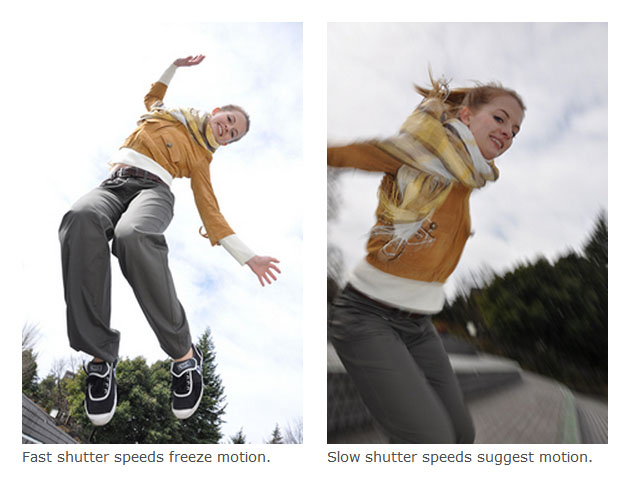Exposure - is the process
of recording light onto your digital sensor. It is basically the
amount of light (controlled by the aperture) that is captured over a specific
amount of time (controlled by the shutter speed). Exposure is determined by three camera
settings: aperture, ISO and shutter speed.
Aperture - is a circular opening in your lens that is adjustable from a very small circle to almost as large as the
lens itself. We adjust it to let more or less light to hit the digital sensor.
Aperture is denoted as fstop and controls along with shutter speed how much
light hits the sensor. Big hole, more light hitting the sensor and small hole
means lesser light hitting the sensor. A higher aperture number (fstop) means a
lower opening and a lower aperture number (fstop) means higher the opening.
Think of aperture numbers as denominators (bottom number) of a fraction and it
would be easy to remember.
Aperture along with distance to your
subject and lens focal length determines depth of field (DOF). The smaller the
fstop (bigger number) the deeper the DOF, where everything is in focus. And the
bigger the fstop (smaller number) the shallower the DOF, where only the subject
is in focus. And by adjusting the fstop values you can determine how much of
the image is in focus.
Shutter Speed - A shutter is a curtain in front
of the camera sensor that stays closed until the camera fires. When the camera
fires, the shutter opens and fully exposes the camera sensor to the light that
passes through the lens aperture. After the sensor is done collecting the
light, the shutter closes immediately, stopping the light from hitting the
sensor. The button that fires the camera is also called “shutter release
button” or “shutter button”, because it triggers the shutter to open and close.
Shutter speed, also known as “exposure time”, stands for the
length of time a camera shutter is open to expose light into the camera sensor.
If the shutter speed is fast, it can help to freeze action completely. If the
shutter speed is slow, it can create an effect called “motion blur”, where
moving objects appear blurred along the direction of the motion. This effect is
used quite a bit in advertisements of cars and motorbikes, where a sense of
speed and motion is communicated to the viewer by intentionally blurring the
moving wheels. Slow shutter speed can cause camera shake which in turn can
produce blurred images. So it’s always a good idea to use a tripod for slow
shutter speeds.
 Shutter
speeds are expressed in fraction of a second 1/8, 1/125, 1/1000 etc. but in
most modern digital cameras you may not see the 1/ expressed (but they still
are fraction). You most likely see the above expressed as 8, 125, 1000 etc.
Shutter
speeds are expressed in fraction of a second 1/8, 1/125, 1/1000 etc. but in
most modern digital cameras you may not see the 1/ expressed (but they still
are fraction). You most likely see the above expressed as 8, 125, 1000 etc.
ISO - In Digital Photography ISO measures the sensitivity of the
image sensor. The lower the ISO number the less sensitive your camera is to
light and the finer the grain. Higher ISO settings are generally used in darker
situations to get faster shutter speeds (for example an indoor sports event
when you want to freeze the action in lower light) – however the cost is
noisier shots. Digital cameras convert the light that falls on the image sensor
into electrical signals for processing.
The slow shutter speeds
needed for dark interior scenes leave photographs prone to camera blur. If you
raise ISO sensitivity, you can choose faster shutter speeds and reduce camera
blur. This is why people say that ISO sensitivity should be raised if lighting
is poor. ISO sensitivity can be set manually by the photographer or
automatically by the camera.
No-Flash Low Light
Photography - When lighting is poor, you can use a flash to light portrait
subjects. Flash units, however, have limited range. If you raise ISO
sensitivity, you can optimally expose both the portrait subject and the
background without using a flash at all.
Noise - Raising ISO
sensitivity allows faster shutter speeds, reducing blur caused by subject or
camera movement. You may wonder why, if that’s the case, you shouldn’t simply
always shoot at the highest ISO sensitivity setting, but in fact raising ISO
sensitivity can introduce a type of image artifact known as “noise” into your
photographs, making them seem grainy. Raising ISO sensitivity amplifies the
electronic signal, which also amplifies any noise in the signal; as a result,
the higher the ISO sensitivity, the more obvious the effects of noise on your
photographs. The same is true of all digital cameras. We recommend that you
raise ISO sensitivity only as high as needed to avoid blur.
Sources: Nikon Website, Photo Tuts+, Digital Photography School











